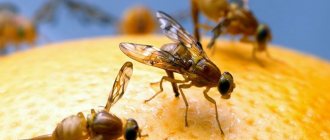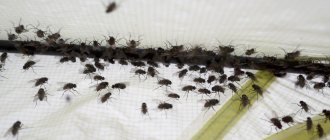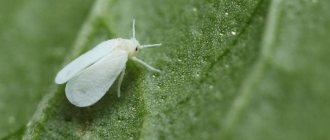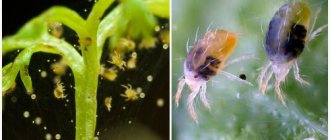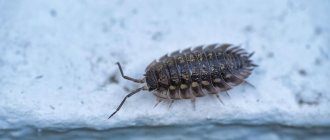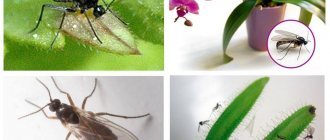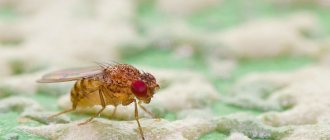Indoor flowers bring a little joy to a person’s life, especially in winter, when there is snow outside and flowering pots adorn the windows. Sometimes such harmony is disrupted by situations when flower growers discover insects on their flowers. What to do when midges appear in indoor flowers, and how to get rid of them? This question is important not only for beginners, but also for experienced flower growers who are faced with this problem for the first time.
Leaf affected by midges
Why are midges dangerous for indoor plants and flowers?
A gardener may not always immediately notice the appearance of insects on his indoor plants. This is due to the fact that midges are very small, and when there are very few of them, the insects are simply not visible. At this time, the larvae grow and develop in moist soil. You can purchase an already infected flower without suspecting anything. At the initial stage of infection, the flower does not show any signs of infection. Looks healthy and continues to bloom.
The midges themselves are not dangerous to the plant, but the eggs they lay are a serious threat to the plant. The larvae feed on roots during development. They are the ones who harm him. If there are a large number of pests, damage to the roots will be very serious.
In addition, the density of the soil in the pot increases, which also has a detrimental effect on the roots of the flower. The flower begins to deteriorate. If you do not notice and take action in time, the plant may die.
Reasons for the appearance of midges in indoor flowers
Growing indoor plants does not require much effort, but it does require more attention and care. Flowers require certain care:
- timely watering;
- loosening the earth;
- feeding
A healthy plant should look like this.
Sometimes midge pests can appear on the plant. There are several common reasons:
- Excessive waterlogging of the soil . When moisture stagnates, favorable conditions for insect reproduction appear. More often this happens in the summer, when the flowers need moisture, and housewives water them generously without waiting for the soil to dry out.
- When the windows are open, fungus gnats often fly into the house . They choose a place to live - a flower pot. To prevent midges from entering the room, it is necessary to place a mosquito net on the windows.
- Poor quality soil for flowers . There are cases when purchased soil for flowers contains particles of leaf humus. This means that the soil has not yet matured, and decay processes continue. The danger is that fungus gnat larvae feed on these particles.
- People sometimes themselves, without suspecting anything, create a favorable environment and conditions for the development of midges, using plant fertilizer from tea leaves, coffee grounds, sugar and water . This cannot be done.
In what flowers do midges mainly breed?
According to the observations of experienced gardeners, not all houseplants are affected by midges. Each group of pests has its own preferences.
| Pest type | Flowers he prefers |
| Fungus midges (sciarids) | Flowers with dense leaves: ficus, violets, azaleas, orchids. |
| Springtails | Plants with delicate leaves: fuchsia and begonia. |
| Whiteflies | Abutilon, pelargonium, fuchsia, orchid. |
| Drosdophila | Flowering plants. |
| Lacewings | Flowers with soft foliage. |
| Thrips | Ficus, dracaena, hyperastrum, violets. |
Midges in orchids: how to get rid of them
An orchid is a tropical plant. To prevent the soil of orchids from souring and rotting, it is necessary to observe a moderate regime in watering these flowers. Insects may appear due to high humidity.
Orchid leaf affected by midges
Seeing midges in flower pots, the question immediately arises: how to get rid of them? But before you start, you need to determine what kind of pests this plant is infected with. Orchids are mainly affected by the following midges: whiteflies, thrips, thrushes and sciarids.
The most dangerous for orchids are thrips. They damage not only the soil, but also the leaves. Infected flowers may die. A distinctive feature of this pest is two stripes on the inside of the body and wing.
It is more difficult to see sciarids (fungus gnats) in the soil. Not only do they burrow into the soil and lay eggs there, but they are also black in color. They feed on the roots and cause the flower to die.
Whiteflies are the easiest to see. They live on the inside of the leaves and suck the juice from the flower. As a result, the trunk and leaves begin to darken.
The appearance of thrush flies is caused by the remains of sour fruits placed near the plant and excessively moist soil of the plant.
This is the look of a wilting plant.
There are many different ways to get rid of midges if they have infested orchid flowers.
How to water orchid flowers to prevent midges
Before getting rid of flower midges, you need to decide on the treatment method.
Before processing, it is necessary to wash the orchid leaves under running water using a flexible hose. In this case, you should try to remove all insects with a soft sponge.
Rinsing an orchid in the shower to remove midges
IMPORTANT
Don't forget your roots! They also need to be washed. Do this very carefully so as not to damage it.
Roots damaged by midge larvae
Then the plant must be treated with insecticides. For each type of insect there is a spray preparation:
| Pests | A drug |
| Fungus gnats | "Raptor", "Neodichlorvos", "Raid" |
| Whitefly | "Sherpa", "Fury", "Aktara" |
| Thrips | "Aktellik", "Fitoverm" |
IMPORTANT
To get a good result, you need to spray the orchid leaves on both sides, and also treat the surfaces on which the flowers are placed.
Spraying orchids with insecticides
The soil also needs to be treated.
Fighting methods
Step 1. First you need to catch all the adult flies. This can be done in the following ways: Place special or homemade traps described in the first instructions. Catch all the midges with a vacuum cleaner.
Pour jam into a saucer, place it next to the pot and wait until the whiteflies fly to the bait and get stuck in it. In the morning, create a slight coolness in the room where the flowers are located, for example, by turning off the radiators or opening a window.
The lower temperature will prevent the flies from taking off. Next, follow the procedure described below. Step 2: Once most of the adult whiteflies have been caught, take the plant to the bathroom and wash the leaves of any remaining insects, eggs and nymphs.
Step 3. Now treat the plant by watering and spraying with solutions of systemic insecticides (Actellik, Confidor, Mospilan or Fufanon), and then create a “toxic greenhouse” by closing the plant in a plastic bag for 4-5 hours.
If there are not so many whiteflies, then instead of special products you can use the garlic infusion described in the first instructions. Step 4: If desired, replant the plant in uninfected soil and discard the contaminated soil.
There is another way to destroy whiteflies in indoor flowers. If the infected plant can tolerate temperatures below 14 degrees, then simply leave it in such a cool place for a week or a little more. Unable to withstand the low temperature, the whitefly and its larvae will die. Question-Answer Why do midges appear in indoor plants?
A common reason is that they could appear when transplanting a plant into purchased soil, which was already contaminated with eggs and larvae. In addition, midges could simply fly in from a window in summer or autumn and settle in your flowers.
One way or another, the main factor in the emergence and reproduction of sciarids and fruit flies is moist, overwatered soil, which attracts midges and creates favorable conditions for the transformation of dormant eggs into larvae.
By the way, fruit flies could get into your apartment along with purchased vegetables, fruits, or fly to the smell of a stale product, and only then take a fancy to your flower pots.
Types of harmful midges and their signs
There are several types of midges that live in indoor flowers.
Springtails (spreads)
These are light midges (from white to yellowish-brown) and very small. They begin to appear in winter, closer to spring. They fly from the leaves to the soil and lay eggs, and in large numbers. Moist soil is their favorite habitat. The larva of this insect destroys the roots of the flower in the shortest possible time.
Springtails
Whiteflies
This insect attacks many indoor plants. The whitefly is very small, its length ranges from 1 to 3 millimeters. Both eggs and adult individuals of this insect can be observed on the leaves of the flower.
The causes of whiteflies are:
- warm air;
- high humidity;
- densely planted plants.
The whitefly is a sucking pest. It is one of the most dangerous and difficult to remove parasites. The larvae suck the juice from the plant and are also carriers of pathogenic viruses. To save the plant, it is necessary to take urgent measures to remove midges from flowers in pots.
IMPORTANT
Whitefly can be confused with scale insects due to the larvae, which are tightly attached to the leaf and are motionless. As you approach the flower, you can see a small cloud of white pests rising up.
Whiteflies
Fungus gnats
Their second name is sciarids. These midges are larger than springtails. They are almost impossible to notice in the soil, as they are black. The midges themselves only annoy humans, but their larvae have a detrimental effect on the plant. They gnaw at the roots and suck out all the microelements from the soil, making it dense, due to which air exchange in the root system worsens. A flower deprived of nutrition quickly dies.
Fungus gnats
Drosdophila
There are cases when fruit flies - Drosophila fly - appear in an indoor flower. This small pest is the safest of all. It does not harm plants, but only creates psychological discomfort for humans. How to get rid of this midge in the kitchen? Everything is very simple. It is necessary to remove the sources of its nutrition: vegetables and fruits that are beginning to spoil, as well as tea leaves and coffee.
Drosdophila
Lacewings
These are small light green insects with translucent, oblong wings. These insects are predators because they feed on various small flower pests. They do not cause any harm to indoor flowers.
They appear in the spring and act as plant attendants, ridding them of many pests.
Midges get into the house when a house flower, which has been standing outside all summer, is brought into the house. The lacewing, living on the plant all this time, was engaged in the destruction of harmful insects and brought benefits. But in the house, the midge does not bring joy to the owner of the flowers. When a midge is discovered in an apartment, the question is how to get rid of it.
Lacewing
Lacewing larvae
Thrips
They are classified as sap-sucking pests. Thrips can be seen quite clearly on a houseplant. They have an oblong body (0.5−1.5 mm) and fringed wings, which when folded form a narrow strip. The coloring of these pests depends on the species. The larvae have the appearance of an adult insect, only without wings.
These pests are well camouflaged and sometimes difficult to spot. Their presence can be determined by the leaves. After sucking the juice from the plant, insects leave marks and brown spots in the area. Over time, the leaves lose their appearance and color, and then fall off.
Thrips also leave sticky traces of their secretions and yellow stripes and spots on the upper side of the leaf. Pests multiply quickly, and they also carry viral and fungal infections. A weakened plant may die within a short time after infection.
Violets affected by thrips.
Thrips larva
Thrips
Question answer
“Why do midges appear on indoor flowers?”
Helpful information
Daria Vorontsova
Amateur gardener. He is interested in growing various greens at home.
Most often, the reason is either improper care of the plant or infection from other flowers (soil). If the conditions for growth and flowering are correct, the spread of pests may have been influenced by the acquisition of a new flower. That is why it is recommended to quarantine such flowers and not place them immediately with other plants.
“What is the harm of midges to indoor flowers?”
Helpful information
Daria Vorontsova
Amateur gardener. He is interested in growing various greens at home.
These pests often feed on plant sap, and due to the rapid increase in the population of midges, the flower quickly withers and dies. They also carry various infections, including viral ones. These are mosaic disease, jaundice, leaf curl and others. Usually they are not treated, so at the first symptoms the flower is thrown away.
How to get rid of white midges in indoor flowers
There are two ways to get rid of flower midges:
- insecticides;
- folk methods.
The pharmacy for gardeners and indoor plant lovers provides a wide selection of pest control products.
Review of pest control products
| Means | Application |
| "Aktara" | Watering the soil and spraying. |
| "Aktellikom" | In combination with Aktara, it enhances the effect. |
| "Tantrek" | After spraying, it retains its effect for three weeks. |
| "Fitoferm" | Completely safe, biological insecticide. |
| "Mospilan" | Spraying. |
| "Intavir" | Spraying. |
| "Fury" | Spraying. |
IMPORTANT INFORMATION!
You can add a couple of drops of shampoo or laundry soap to the prepared solution of the drug to prolong the effect of the insecticide when spraying! The shampoo sticks the drug to the leaves.
The drug "Fitoverm"
The drug "Iskra"
Folk remedies
At the initial stage of infection, folk remedies help well. The easiest way is a trap.
First you need to take yellow paper (color plays a big role, since it is very attractive to whiteflies). Lubricate completely with Vaseline (so that midges can stick) and place in a pot with an infected flower.
Several proven recipes for white midges:
| Folk remedy | Preparation | Application |
| Potassium permangantsovka | You need to prepare a 0.1% solution. The color should be pale pink. | It is necessary to spill the soil in the pot. |
| Dandelion | 15 grams of roots and 20 grams of dandelion leaves should be poured with 0.5 liters of water and allowed to brew for about 6 hours. | Spray the plant once a week. Use for two weeks. |
| Garlic | Pass 5 grams of garlic through a garlic press, add 0.5 liters of water and leave for a day. | Spray the affected leaves. |
| Sagebrush | Steam 3 tablespoons of herbs with 200 grams of boiling water. Leave for 2 hours. | The affected leaves are washed with this infusion. |
Description of the pest
Flower midges have a thin and narrow body 0.5–3 mm long and a round head. The body and long legs are gray or black. The antennae are long, consisting of 8–16 segments.
The front pair of wings are transparent and well developed. The hind wings have lost their purpose and are transformed into thoracic appendages - club-shaped halteres. The oral organ in adult insects is of the sucking type, but it is poorly developed.
The length of flower midge larvae is 2–10 mm. These are white shiny worms with a black head capsule. The dark intestine is visible through the translucent walls of the larva. The mouthparts are gnawing.
How to deal with black midges on indoor plants
The fight against black midges also occurs with the use of insecticides and traditional methods.
Review of remedies for midges in the soil of indoor plants and how to get rid of them
| Facilities | Application |
| "Regent" | The drug must be dissolved in water according to the instructions and watered the ground. |
| "Inta-vir" | Dilute the powder or tablet in the required amount of water and spill it on the ground. |
| "Agravertine" | After dilution, the indoor flower is sprayed with it. Kills midges, but not larvae. |
| "Fly-eater" | This is an environmentally friendly product. It looks like granules. It is introduced into the ground when a plant is replanted or the soil is loosened. |
| "Thunder 2" | Remove the top layer of soil and sprinkle the soil with the product. Cover the top back with soil. Kills both larvae and midges. |
How to get rid of midges on flowers using folk remedies
A trap for black midges can be made according to the same principle as for white midges.
Black midges on a trap
You can buy a ready-made trap
| Folk remedy | Preparation | Application |
| Soda solution with manganese | Take manganese on the tip of a knife and 1 teaspoon of soda. Dissolve in 2.5 liters of water. | The plant needs to be watered with this solution for 2 weeks. This method is good at ridding the soil of larvae. |
| Soap solution | Dissolve 100 grams of laundry soap in 500 grams of water. | Use a napkin soaked in the solution to wash the leaves and trunk of the plant. |
| Sulfur | Midges cannot tolerate sulfur. You need to take regular matches. | Insert match heads into the ground. When watering, a sulfur smell is formed, which frightens midges. |
Manganese for killing larvae
Measures to prevent the appearance of midges
- It is necessary to frequently inspect indoor plants for pests.
- Water only when the top layer is dry.
- Drain excess water from the pan.
- Take time to loosen the soil in the pot to allow oxygen to reach the roots.
IMPORTANT
Midge infestation is easier to prevent than to treat.
Review of popular midge repellents in flower pots
Recently, products for indoor plants have become very popular: “Mukhoed G” and “Thunder 2”.
"Thunder 2" from midges: instructions for use
When, when midges are detected, there is no desire to look for a traditional method, experienced flower growers recommend a 100% drug for the destruction of midges and their larvae.
“Grom 2” is designed to combat soil midges and fungus gnats in potted flowers. On the street it is used to fight ants.
The drug is used once. In the pot you need to remove the top layer of soil and scatter the poison. Then pour the previously selected soil on top. The problem in the form of insects is solved within 3-5 days.
This drug is completely safe for plants. Moderately dangerous for animals and people. Restrict access to children.
First you need to carefully study the instructions for use.
Drug "Thunder 2"
"Fly beetle G" for soil pests: instructions for use
This drug has a wide spectrum of action on various pests.
Made in granule form, very easy to use. It is used both indoors and on outdoor plants.
Apply only once per season when planting a plant or loosening the soil.
IMPORTANT
This drug does not accumulate in the soil. It is safe and environmentally friendly for flowers.
Mechanical method
To enhance traditional or chemical methods, change the soil in the pot. At the same time, the root system is carefully inspected, rotten fragments are removed, and the new soil is sterilized. This is the only way to remove sleeping black mosquito larvae, as they adapt well to changing watering regimes. You can get rid of other insects by reloading the clod of soil and removing the top 3-4 centimeters of infected soil.
Drosophila can be lured into a trap. You will need half an apple, the bottom of a plastic bottle and a transparent bag. The fruit is placed in a container and covered with polyethylene on top. Insects get inside through small holes, but cannot get out.
A fairly simple method involving soaking is suitable against jumping springtail larvae. Place the infected pot in a deep container and fill it with warm water to a level a couple of centimeters above the soil surface. The larvae float to the surface, they are removed, and the container with the plant is dried.


